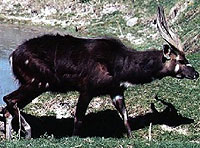 |
| Language | Name |
| Afrikaans | Waterkoedoe |
| Tswana | Nakong |
| Lozi | Sitatunga |
| Yei | Unzunzu |
|
|
|
|
Shy and retiring, the sitatunga are semi-aquatic, spending a considerable part of their lives in swampy terrain. Throughout their wide, but scattered distribution, coloration and pattern marking varies considerably. In the Sudan and East Africa adult males display shadow stripes on their bodies and dark dorsal crests. In the Southern African subregion, however, males are drab dark brown with no body stripes.
Adult males are larger than their female counterparts, standing at an average height of between 80 and 130cm (30 to 50 inches) and an average mass of between 70 and 125kg (150 to 275lbs). Ewes, on the other hand, have an average height of between 70 and 90cm (30 to 36 inches) and an average mass of between 50 and 60kg (110 to 124lbs).
Coloration of the ewe varies from dark to reddish brown, with a black band down the centre of the back, four vertical stripes on the sides, white lateral band and white spots on the haunches. Both males and females have an incomplete white band between the eyes with white spots on the cheeks. There are also two white patches, one above the chest and another below the chin. Their tails are dark brown on top with a lighter white underside.
The hooves, splayed and covered with a swollen leathery pad, are a characteristic feature of the sitatunga, a unique adaptation to their watery environment. Only males have horns, which are relatively long (mid-way between those of bushbuck and kudu) and spiral in shape, with white/yellow tips.
Sitatunga have a wide but patchy distribution throughout southern and central Africa south of the Sahara. They have been recorded in Benin, Togo and Nigeria and in isolated populations in Cameroon, the Central African Republic and the Sudan. They are widespread throughout the Democratic republic of Congo and also occur in parts of Uganda and in Kenya and Tanzania around Lake Victoria. In Zambia they occur west of the Muchinga escarpment, but are absent from the Zambezi valley. An isolated population exists in central Angola. In southern Africa, they occur throughout the Okavango Delta in Botswana and in the Chobe/Zambezi swamps.
Semi-aquatic, sitatunga spend most of their time in and around dense swampy reed-beds with water to a depth of a metre. In times of flood they are forced to move to the shallow fringes of the swamp, where they spend their time seasonally among the aquatic grasslands, often venturing into drier fringing woodland forest at night to browse.
Sitatunga are active throughout the day and night, resting during the hottest hours of the day on flattened platforms of reed and papyrus which they prepare by circling and trampling. They occur in small herds of up to six individuals consisting of an adult male with several females and juveniles. During the day when feeding they tend to scatter. At night they regroup moving in closely knit groups for protection.
Sitatunga are very sensitive to sound, bounding off at the slightest noise. They do not move very far, stopping 50 to 100 metres away to check for any further disturbances. When in imminent danger, they submerge themselves, only their nostrils protruding above the surface. They are excellent swimmers, and more often than not, when under threat, will take to deep water to escape danger. When satisfied that the danger has passed they will resume feeding. Their intricate network of established paths is used for movement from one area to another, making them particularly vulnerable to human predation.
Whilst their swampy environment affords reasonable protection from predators, they are preyed upon by lion, wild dogs and to a lesser extent leopard.
Sitatunga feed primarily on fresh sprouting tips of reeds and bull-rushes, aquatic plants and grasses from shallower water, and browse from selected woodland plants and young trees, often standing on their hind legs to reach high flowers. Males have been observed using the back of their horns to pull down and break branches from trees.Predominantly grass eaters.
After a gestation period of approximately 220 days, ewes drop a single calf. The bulk of calving takes place during the dry winter months (July - September). Mothers conceal the young on reed platforms deep within the swamp.
|